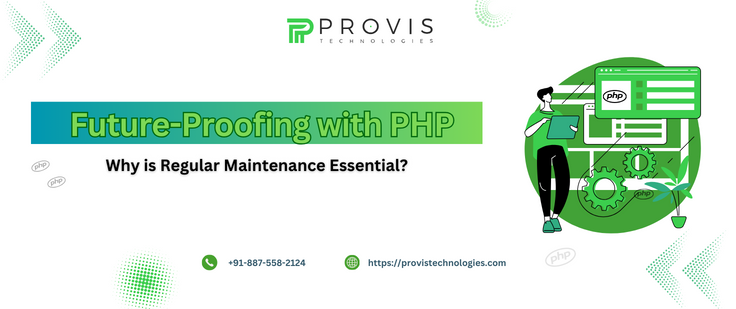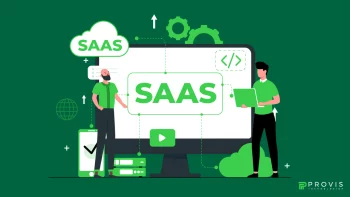Staying ahead of the curve in the www environment is not just a choice; it’s a necessity. As businesses increasingly rely on digital platforms, the need to maintain & future-proof the technologies supporting these platforms becomes crucial. Today, we will talk about PHP, a server-side scripting language that powers a substantial portion of the web. And also explore why regular maintenance is essential for future-proofing PHP applications.
Understanding PHP’s Pervasive Presence
PHP (Hypertext Preprocessor) has been a stalwart in web development since its inception in the mid-’90s. Its versatility, ease of integration, and robust community support have contributed to its enduring popularity. From small-scale websites to large-scale applications, PHP plays a pivotal role in the digital landscape, including popular content management systems like WordPress, Drupal, and Joomla.
However, as with any technology, PHP is not immune to the relentless march of time. Ensuring the longevity & relevance of PHP applications requires a proactive approach to maintenance and continuous improvement.
The Need for Future-Proofing
Security Concerns
Security vulnerabilities are inherent risks in any software, and PHP applications are no exception. Staying vigilant against potential threats, applying security patches promptly, and implementing robust security measures for cyber threats – are a part of regular maintenance. Future-proofing with PHP means staying one step ahead of potential exploits and ensuring the confidentiality & integrity of user data.
Compatibility Challenges
In the tech domain, new versions of server software, databases, and frameworks are released regularly. Failure to keep PHP applications up-to-date can result in compatibility issues with the latest software versions. Regular maintenance involves testing & adapting applications to ensure seamless compatibility, preventing unexpected glitches that can arise from running outdated code on updated infrastructure.
Performance Optimization
Over time, as user bases grow and features are added, PHP applications may experience performance bottlenecks. Future-proofing involves identifying & optimizing code for improved efficiency. Regular performance tuning ensures that applications meet current performance expectations and scale as user demands increase.
Adopting Modern Practices
Embracing modern coding standards, design patterns, and development methodologies ensures that PHP applications remain relevant & maintainable. Regular maintenance allows developers to refactor and enhance codebases – keeping them in line with the latest industry best practices.
Don’t Miss:- All You Need to Know About Website Downtime & Ways to Prevent It
The Maintenance Checklist for PHP Applications
Update PHP Versions
Periodically updating PHP to the latest stable version is crucial. New versions often include performance improvements, security fixes, and features that enhance the language’s capabilities.
Security Audits
Conduct regular security audits to identify & address vulnerabilities. This involves scrutinizing code, dependencies, and server configurations to ensure a robust defense against potential cyber threats.
Database Optimization
Optimize database queries and structures to improve performance. Regularly review and refine database design to accommodate changing application requirements efficiently.
Code Refactoring
Refactor outdated or inefficient code to enhance readability, maintainability, and performance. This process involves restructuring code without altering its external behavior, improving its long-term sustainability.
Dependency Management
Keep third-party libraries and dependencies up-to-date. Regularly review and update these components to leverage new features, performance enhancements, and security patches.
Performance Testing
Conduct regular performance tests to identify bottlenecks and optimize code accordingly. This ensures that the application remains responsive, even under increasing loads.
Backup & Disaster Recovery
Implement and regularly test backup and disaster recovery plans. This safeguards against data loss and ensures a swift recovery if any unforeseen incident occurs.
User Experience Enhancement
Collect feedback from users and check to find out the scope of improvement. Enhance the user experience through incremental updates and feature additions.
Must Know:- How to Improve User Experience on Your Website?
The Role of Developers & DevOps in Future-Proofing
Future-proofing PHP applications is a collaborative effort that involves developers, DevOps teams, and stakeholders. Here’s how each plays a crucial role:
Developers
Code Quality
Developers contribute to future-proofing by writing clean, maintainable, and efficient code.
Adopting Best Practices
Embracing modern coding standards and best practices ensures the codebase remains adaptable and scalable.
Continuous Learning
Staying informed about the latest PHP developments, security threats, and industry trends allows developers to make informed decisions.
DevOps Teams
Infrastructure Maintenance
DevOps teams ensure that server infrastructure, including PHP runtime environments, is regularly updated and optimized.
Automation
Implementing automation for routine tasks, such as testing, deployment, and monitoring, streamlines the maintenance process.
Collaboration
Facilitating collaboration between development and operations teams ensures a holistic approach to future-proofing.
Stakeholders
Resource Allocation
Providing the necessary resources, such as time & budget for regular maintenance, is essential for long-term sustainability.
Aligning with Business Goals
Stakeholders help in maintenance efforts by overarching business objectives and promoting the organization’s strategic growth.
Conclusion
Future-proofing with PHP is not about resisting change but embracing it strategically. Regular maintenance ensures that PHP applications evolve with the technological landscape – remaining secure, performant, and aligned with business goals.
For businesses relying on PHP applications, the investment in regular maintenance is an investment in the long-term viability of their digital assets. It’s a proactive approach that safeguards against potential risks, optimizes performance, and sets the stage for continuous innovation.
In conclusion, as we navigate the ever-changing currents of technology, future-proofing with PHP through regular maintenance is a must practice. It’s a commitment to resilience, relevance, and sustained success in the digital realm. Companies like Provis Technologies can also do good for you.
Written By
Author's Picks
- Unlocking the Secrets 5 Website Maintenance Hacks Every Business Owner Should Know!
- 30/11/2023
- How to Improve User Experience on Your Website?
- 27/01/2024
- A Step-by-Step Guide to Website Optimization Strategies for 2024
- 04/01/2024
Categories
- AI for Startups
- AI in Web Development
- AI Integration
- AI Platforms
- AI Prompt
- AI Tools
- AI Trading Software
- Android App
- Android vs iOS Development
- Angular
- API
- API Development
- App
- app development
- App Idea
- App User Feedback
- Application
- Artificial Intelligence
- Audit Services
- Automotive Industry
- Awards and Recognition
- Business Consulting
- Business Website
- Chatbots
- CRM
- CRM for Financial Advisors
- Custom CRM
- Custom SaaS
- Custom Website
- Customer Service
- dashboard design
- Developing a Mobile App
- Digital Business
- E-commerce
- EMR Integration
- Finance
- Financial Advisors
- Financial Advisors
- GIT
- Health Insurance
- iOS App
- iOS App Development
- IoT Mobile App Development
- IoT Platforms
- IT Audit Services
- IT Consulting
- IT Strategies
- Java Development
- Laravel
- Lean Canvas
- Learning Management System
- Logistics Apps
- Mobile App Development
- MVP
- Native App
- News Aggregator Site
- OTT
- Outsourcing IT
- Payment Gateway
- predictive analysis
- Product Launch Strategy
- Progressive Web App (PWA)
- Prototype
- Recommender Systems
- Ruby
- SaaS
- SaaS Application
- SaaS Business
- SaaS Company
- SaaS Development
- SaaS Product
- SaaS Project
- Sales Funnel
- SEO
- Shopping Cart
- Software Development
- SSL and TLS
- Startup Checklist
- Technology
- Tetradic Color Scheme
- UI/UX Design Company
- Unit Testing
- User Flow
- User Testing
- Web Development
- Web Performance Optimization
- website Maintenance Services
- Website Migration Service
- Website Speed Optimization
- WooCommerce
- WordPress





